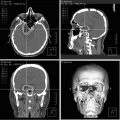Fig. 11.1
The main components of the CyberKnife system. (Modified image used with permission from Accuray Incorporated)
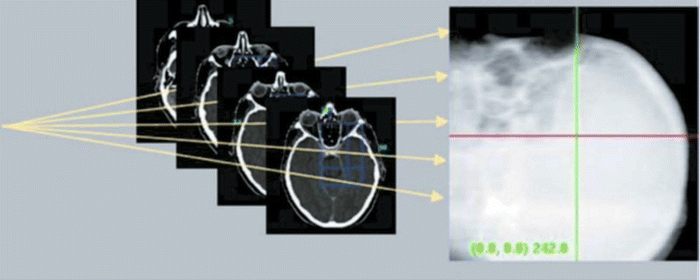
Fig. 11.2
A library of digitally reconstructed radiographs (DRRs) is generated from the treatment planning CT. Each of these images, which approximates an oblique projection, emulates a unique pose of the patient’s anatomy
The system uses a large number of narrow circular beams emanating from a wide array of directions that accumulate within the predefined target volume, thus allowing more than 100 non-isocentric, noncoplanar beams to be used during the process of designing a treatment plan and creating a dose distribution that conforms to even irregularly shaped target volumes (Fig. 11.3). In contrast, frame-based isocentric radiosurgery systems (e.g., Gamma Knife and linac-based systems) construct spherical dose distributions around a discrete isocenter, and irregular targets require multiple spheres to ensure adequate dose coverage.
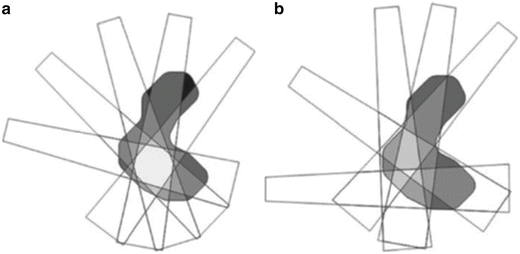

Fig. 11.3
(a) With standard radiosurgery dispersed isocentric beams, all beams intersect a common region (light gray). Because multiple spherical volumes are needed to cover irregular lesions, the resulting dose distribution tends to be inhomogeneous. (b) Non-isocentric beams from various directions. Beams do not all cross in a single point and dose need not be inhomogeneous
Recent developments in hardware and software have significantly enhanced the delivery efficiency to reduce patient treatment times. The newer CyberKnife G4 system is capable of a dose rate up to 1,000 MU per minute in up to 1,600 beam directions. The newly designed RoboCouch™ aligns patients quickly from the control room with a high degree of accuracy in six degrees of freedom so that setup time can be reduced. The IRIS variable collimator system is capable of changing the collimator size during delivery (Fig. 11.4). In combination, these features have been able to significantly reduce treatment time. For brain and spine cases, the typical treatment time in the current G4 system ranges from 15 min to 1 h depending on the complexity of the treatment sites, with an average of approximately 30 min.
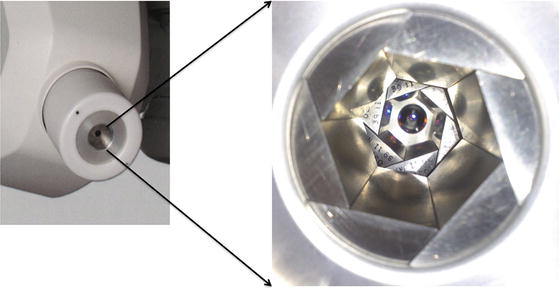

Fig. 11.4
The IRIS collimator includes two banks of tungsten segments capable of rapidly manipulating beam geometry to deliver up to 12 beam sizes from each position
CyberKnife Treatment Planning
Treatment planning with CyberKnife is similar to frame-based technology in that it is developed on CT image data with other imaging modalities such as MRI, fMRI, and PET scans coregistered for target volume delineation. For lesions of the brain, head, and neck, a thermoplastic head mask is fabricated for immobilization. For body lesions, a custom vacuum body mold may be used. In order to generate high-resolution DRRs for image guidance during delivery, the planning CT is acquired at 1.0–1.5 mm slice thickness.
The CyberKnife treatment planning system is capable of generating both isocentric and non-isocentric treatment plans. Non-isocentric treatment delivery marks a stark contrast to earlier technology and is particularly useful in treating irregularly shaped targets. The total system accuracy is similar to previously published results from frame-based radiotherapy and is less than 1 mm [3, 4]. The CyberKnife uses 12 secondary collimators to shape cylindrical beams with diameters ranging from 5 to 60 mm. While other treatment planning systems may use forward planning, in which beam angles and weights are adjusted manually by the physicists or dosimetrists, all the CyberKnife planning is done using an inverse approach. For more complex and irregularly shaped tumors, robotic radiosurgery provides an enormous range of possibilities for placing beams and beam arrays. In designing plans for these targets, the goal of the CyberKnife planning algorithm is to find a beam arrangement that returns a maximally conformal distribution for a given shape of target [5, 6].
The optimization process is based on a set of goals and dose constraints specified by the user. The treatment planning system determines the directions and activation durations for each non-isocentric, noncoplanar beam (selected from a universe of approximately 2,000 beam directions) such that the user’s specifications are met. A typical plan utilizes more than 100 beam directions in a single treatment.
The sequential optimization algorithm was introduced in newer planning systems to improve the efficiency of the planning process [7]. Unlike the standard optimization process, which optimizes on a set of clinical objectives at the same time, the sequential optimization option is composed of a series of individual optimization steps, which are performed in a defined sequence in the order of priority. Each step corresponds to a clinical objective. The solution of each prior step is maintained or relaxed by a user-defined value when the next step is optimized. The process closely mimics the clinical decision making of a physician in designing a treatment plan. The steps and user-defined constraints comprise a script that can be saved so that the treatment planning process with similar targets can be standardized, thus reducing planning time for subsequent plans.
The use of multiple collimators can improve plan conformality and reduce the treatment time [8]. The introduction of the IRIS variable collimator, which provides an aperture size ranging from 5 to 60 mm, has made it practical and feasible to use more collimator apertures in treatment planning. The IRIS collimator is designed with two sets of tungsten collimator banks, each of which forms a hexagonal shape rotated 30° apart to form a semicircular shape (Fig. 11.4). In the current implementation, the IRIS beam apertures are incremental to match the fixed collimator set.
Previously, the raytracing algorithm (pencil-beam-based algorithm) was used exclusively in the CyberKnife treatment planning system. Since 2008, the Monte Carlo (MC) calculation option has been available for CyberKnife treatment planning. The CyberKnife MC calculation is a Monte Carlo simulation with modifications to improve calculation speed [9, 10]. This calculation algorithm more accurately predicts dose in inhomogeneous areas such as the lung as evidenced by a study by Wilcox et al., who compared the traditional raytracing calculation with the MC calculation in lung tumors for the CyberKnife system and showed that the raytracing calculation consistently overestimated doses in low-density structures (the maximum dose deviation up to a factor of 1.63 observed), and this effect was more pronounced as the collimator size decreased [11].
CyberKnife planning has also been extended to the case of moving targets [12, 13]. While the target may move during treatment, critical structures in the vicinity may not move with the same speed or direction. The relative motion of organs with respect to one another requires highly accurate planning. The temporal changes over the entire respiration cycle are represented in a motion model (obtained from either four-dimensional CT or by deforming an inhalation image stack into an exhalation image stack), which is then used for treatment planning. The linear programming approach used by the CyberKnife can be extended to four-dimensional inverse planning [14].
One of the major limitations of CyberKnife is the extended delivery time for patients. Options for reducing the treatment time are available in the planning system by reducing the number of beams, nodes (positions of the robotic arm), and monitor units while preserving the integrity of the treatment plan [15]. In addition, the optimized path traversal feature now allows the robotic arm to travel the shortest safe distance between nodes to deliver the treatment, thereby minimizing the amount of motion required by the robot and reducing treatment time significantly [16].
CyberKnife Treatment Delivery
The CyberKnife treatment delivery follows a step-and-shoot manner. The robot travels along a set of predefined paths, stopping at treatment nodes to deliver the dose. The design advantage of the CyberKnife treatment delivery is its automated near real-time image guidance. During treatment, X-rays are frequently acquired and compared to the DRRs obtained at setup to automatically compensate for patient movement within a range of 10 mm. The robotic arm of the CyberKnife is realigned before delivery of each beam to account for translation and rotation of the target. If a significant misalignment is present, radiation delivery is postponed until the misalignment is corrected by movement of the treatment couch [17]. While the system is capable of imaging before every treatment beam, imaging every third to fifth beam or every 20–60 s, depending on the compliance of the patient, is generally sufficient. The accuracy of this system design has been demonstrated to be submillimetric [18, 19] and is comparable to frame-based systems [18–22].
The CyberKnife is capable of real-time tracking of targets that move with respiratory motion with the Synchrony™ system. Synchrony™ synchronizes internal motion of the target by X-ray localization with the motion of the chest wall as assessed by continuous infrared light emitting diodes placed on the chest wall near the diaphragm that are detected by an optical camera in the treatment room (Fig. 11.1). As the patient breathes, the movement of the chest wall is correlated with internal movement by a predictive model updated during treatment (Fig. 11.5). The most recent 15 data points captured from the X-ray imagers are used for model prediction updated in a first-in first-out manner. With the feedback from Synchrony™, the radiation beams remain fixed on the target while the robotic arm moves to account for tumor motion with respiration. If the detected target position is significantly different from the predicted position when the patient’s breathing pattern changes, the treatment will be turned off until the patient resumes a normal breathing pattern. A new modeling procedure may be required if the patient moves significantly or the breathing pattern changes significantly (e.g., when the patient is awake vs. when the patient is sleeping). The additional tracking with Synchrony™ typically prolongs the treatment time by 20 %.
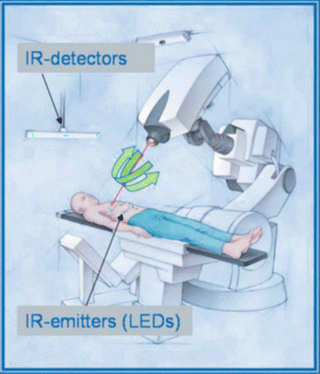

Fig. 11.5
This schematic illustrates several aspects of dynamic respiratory compensation with the Synchrony™ system. In this situation, the movement of a lung tumor is determined in real time by correlating the location of internal gold seeds (not visible) with external markers (IR emitters). Tumor position is then fed back to the robot, which adjusts accordingly for tumor motion
With the capability of image-guided motion tracking, CyberKnife stereotactic radiosurgery represents a departure from the previous notion of radiosurgery as solely an intracranial treatment. Such refinements in technology have broadened the clinical spectrum to include treatment to sites in the spine, head and neck, lung, prostate, pancreas, and liver.
Image Guided Tracking System
Image-guided tracking of lesions is one of the key components in the CyberKnife radiosurgery. Different image tracking algorithms are implemented for different anatomic sites, which include Skull tracking, Fiducial tracking, XSight Spine tracking, and XSight Lung tracking.
For intracranial lesions, the Skull tracking algorithm is applied. It uses the bony anatomy of the skull as a reference to continually track intracranial targets and correct for translational/rotational target shifts during radiation delivery. A 2D–3D fast image registration algorithm [3] registers the images acquired during treatment with the treatment planning CT (through a library of pregenerated DRRs at different rotation angles) using skull bony anatomy. Any misalignment is corrected with frequent imaging during the treatment. Treatment of cranial lesions with the CyberKnife compares favorably to more conventional frame-based intracranial radiosurgery in terms of dose conformality and targeting accuracy [18].
Fiducial tracking with or without Synchrony™ is often used in stereotactic body radiotherapy with CyberKnife. Historically, fiducial tracking has been implemented to adequately localize spinal targets. This tracking system involves percutaneous implantation of radio-opaque fiducials under fluoroscopic guidance, typically three to four 4 × 2 mm stainless steel screws placed in the vertebrae adjacent to the target lesion. For other thoracic and abdominal lesions, at least three small 0.8 × 4 mm gold seeds are placed in close proximity to the lesion. The Fiducial tracking algorithm compares the positions of the fiducials on X-rays acquired near real time to their location on the DRRs and adjusts the treatment beam accordingly [23]. If the target motion is correlated with respiration, such as lung, liver and pancreas lesions, the Synchrony™ motion tracking option is usually used during delivery. If the target movement is caused by patient movement or internal bowel movement, such as spine and prostate, frequent imaging between beams is applied.
The clinically relevant accuracy of Fiducial tracking in spinal lesions was investigated by Yu et al. [19]. In this study, measurements were performed at three different CyberKnife facilities using head and torso phantoms loaded with packs of radiochromic film. The absolute displacement of the dose contours from that defined during treatment planning was reported to be submillimeter. The average offset was 0.3 ± 0.1 mm. The fiducial tracking error was below 0.3 mm for radial translations smaller than 14 mm and less than 0.7 mm for rotations up to 4.5°.
For treatments that require Synchrony™, the tracking accuracy largely depends on the accuracy of the correlation model of the internal motion and chest wall motion. In end-to-end tests with a phantom (with perfect linear correlation between external motion and internal motion), the CyberKnife is found to be able to follow the lesion with submillimeter accuracy [24]. Perfect correlations do not exist on real patients due to the irregular breathing and hysteresis in tumor motion, so small residual errors remain during treatment. The residual error is dependent on the quality of the correlation model and is proportional to patient and tumor motion. Pepin et al. studied the correlation and prediction uncertainties based on 100 CyberKnife Synchrony™ models for lung patients [25]. With 95 % modeler point coverage, the uncertainty was 1.2 mm in the lateral direction, 1.7 mm in the anterior–posterior direction, and 3.5 mm in the superior–inferior direction. Appropriate margin should be considered during PTV delineation to account for this uncertainty.
Fiducial-free tracking is now available for spine radiosurgery, which increases patient convenience and reduces risks associated with fiducial placement. XSight Spine tracking was initiated in 2004 and allows for tracking of spinal skeletal anatomy based on anatomic landmarks [26, 27]. Similar to the skull-based algorithm, the XSight Spine tracking algorithm aligns the live X-ray images with the DRRs generated from the setup CT. DRRs are often synthesized with the spine region only to remove moving structures and are enhanced with imaging processing for more robust tracking. Instead of using the whole image, the XSight Spine algorithm only uses a region of interest defined by the user that includes the spine bony structures near the treatment area (Fig. 11.6). Because the spine is not a rigid body, the ROI is divided into many small nodes (9 × 9 mesh), and the small area near each node is treated as a rigid body. They are registered to the DRRs separately using maximum similarity mapping. The detected displacement of each node constructs a displacement vector field which is used to determine the overall translations and rotations. This approach has been shown to target spinal lesions with submillimeter accuracy and compares favorably to previously published precision of fiducial-based localization [4].
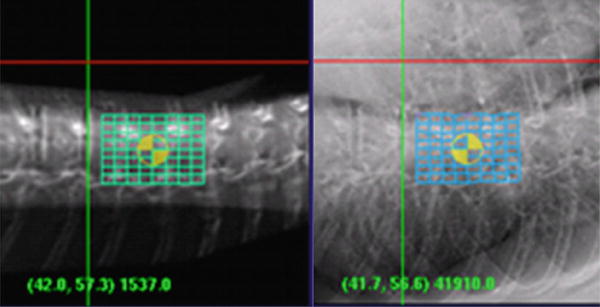

Fig. 11.6
XSight Spine tracking compares the (left) digital reconstructed radiography (DRR) with the (right) live image in a region of interest (ROI) defined by the user which includes the maximum spine structures located on or near the treatment area. The DRR is synthesized with the moving structures excluded to increase the robustness of the tracking method
Similarly, XSight Lung Respiratory tracking system has emerged as an option for fiducial-less tracking of lung lesions [28]. The XSight Lung algorithm directory tracks the tumor using the live images taken during the treatment (Fig. 11.7). The GTV is contoured during the planning process to be used as the tracking target, and a maximum similarity matching technique is applied near the GTV region for tracking. This tracking system only corrects for translational displacements, and the rotations of the tumor are ignored. The patient using XSight Lung is set up with XSight Spine tracking first to correct for any patient rotations. This system works best for lesions with sufficient contrast from normal surrounding tissue. Fu et al. found this approach can be used on peripheral, radiodense tumors with diameters >15 mm [29]. The XSight Lung tracking system uses Synchrony™ to correct the detected internal motion that is correlated with respiratory chest wall movement [24].
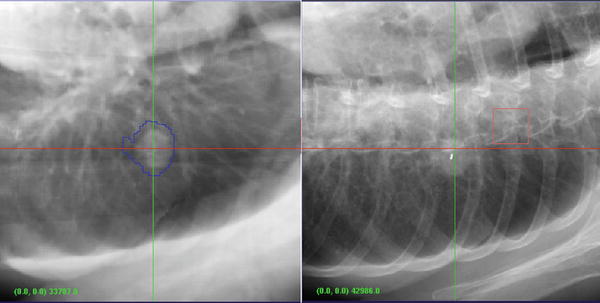

Fig. 11.7
XSight Lung tracking directly tracks the tumor volume without implanted fiducials. The displacement is determined with maximum similarity measures within the matching window
In summary, the CyberKnife tracking systems in place can track lesions in any direction throughout the body, thus facilitating treatment of both intra-cranial and extracranial sites. Submillimeter accuracy is achieved with CyberKnife systems for Skull, Fiducial, and XSight Spine tracking methods [17]. For lesions that move with respiration, adequate margin should be considered.
Clinical Indications
CyberKnife is capable of targeting most lesions treated with the more conventional frame-based radiosurgery techniques. With the advent of stereotactic body radiotherapy, the clinical indications for use with the CyberKnife have been expanded from intracranial to extracranial, including bone, lung, pancreatic, hepatic, and prostate disease. Doses of radiation vary depending on location. The main clinical goals of stereotactic radiosurgery are to improve local control, alleviate pain, or prevent tumor progression which could result in symptoms. While a full review of each of these disease sites is beyond the scope of this chapter and can be found in other chapters of this textbook, what follows is a brief discussion of each site specifically with respect to how CyberKnife has been used and the reported clinical results.
Intracranial
Most conditions treated with standard frame-based radiosurgery are readily treatable with the frameless CyberKnife using the same basic radiosurgical principles. However, the combination of near real-time image guidance and robotic treatment delivery can offer distinct advantages over conventional frame-based radiosurgery under some clinical circumstances. Because of its robotic nature, the CyberKnife enables an increase in both the range of beam trajectories and, in some cases, the volume of space over which they are distributed. Clinically speaking, this design provides greater homogeneity, when desirable, and enhanced dose conformality for irregularly shaped targets. Even more importantly, frameless stereotaxy allows for multi-fraction dosing schedules, which may be used if late radiation damage is of concern.
The CyberKnife can be used to treat all the common intracranial conditions currently treated with other radiosurgery systems, such as intracranial tumors, arteriovenous malformations, and functional disorders such as trigeminal neuralgia. However, the use of hypofractionation makes it feasible to treat many larger tumors or lesions adherent to particularly radiosensitive brain structures such as the anterior visual pathways. Moreover, CyberKnife radiosurgical ablation is readily extended to lesions that originate beneath or extend through the skull base, such as tumors of the foramen magnum and nasopharyngeal carcinoma.
Shimamoto et al. reported results of 94 patients with 136 brain metastases treated with doses of 24–27 Gy using CyberKnife, showing 89 % local progression free survival [30]. In a series from Stanford University, Chang et al. treated 53 patients with 149 brain metastases with a median dose of 19.6 Gy (range 14–30 Gy) with 91 % rate of local control, defined as stabilization or decrease in lesion size. Eight patients (5.4 %) had radiation brain necrosis [31]. Another series of 71 patients with 148 metastatic brain lesions with mean volume of 6.6 cm3 treated with median dose 20.7 Gy over 1–3 fractions showed local control rate of 83 % at 44 weeks of follow-up [32]. Hara et al. reported a local control of 87 % in 62 patients with 145 renal cell or melanoma metastases. The median prescribed dose was 20 Gy (range 14–24 Gy). Prior surgical resection did not impact local control [33].
Without adjuvant irradiation, local control after surgical resection of a brain metastasis is no greater than 40 % in prospective trials, leading investigators to examine adjuvant radiosurgery to the resection cavity [34, 35]. Using CyberKnife, Choi et al. reported high local control rates and acceptable toxicity in an updated series of 112 patients with 120 resection cavities treated with adjuvant stereotactic radiosurgery with a median dose of 18.6 Gy (range 15–30 Gy). The average cavity volume was 8.5 cm3 with 12- and 24-month cumulative local failure rates of 9.5 % and 11.6 %, respectively [36]. Stanford is now leading a prospective trial investigating dose escalation for large brain tumors or large resection cavities of 2–5 cm in size [16].
Glioblastoma Multiforme
Investigators have reported on the use of CyberKnife for primary brain tumors such as glioblastoma multiforme (GBM). Villavicencio et al. reported a series of 20 patients treated with CyberKnife at the time of initial diagnosis of GBM and 26 patients treated at the time of disease recurrence or progression [37]. The group treated with CyberKnife at time of recurrence or progression had a median survival rate of 21 months compared to 11.5 months in the group treated upfront with stereotactic radiosurgery. Patients with more extensive surgical resection had improved survival rates.
Conti et al. recently investigated a series of 23 patients with unresected GBM treated with radiation alone using CyberKnife stereotactic radiosurgery alone or combined with temozolomide. Median survival was 12 months for the group that received combination treatment compared to 7 months in the group that received stereotactic radiosurgery alone. While surgery remains the standard of care for the treatment of GBMs, the vast majority of failures (90 %) occur within 2 cm of the original tumor [38]. CyberKnife stereotactic radiosurgery is currently being investigated as adjunct therapy following surgical resection in a prospective trial at Stanford.
Perioptic Tumors
The use of hypofractionation enables treatment of lesions near radiosensitive tissue such as the optic structures, which are not well suited for single fraction treatment. High rates of local control and visual preservation after hypofractionated radiosurgery have been reported [39–41]. Adler et al. updated a series of 49 patients with perioptic tumors within 2 mm of the optic apparatus treated with CyberKnife radiosurgery with excellent local control rates. Lesions included meningiomas, pituitary adenomas, craniopharyngiomas, and one case of mixed germ cell tumor, most of which had been previously treated with surgical resections and/or conventional radiation therapy. These lesions were treated with a mean cumulative marginal dose of 20.3 Gy in 2–5 fractions. They reported local control >95 % and visual preservation rate of 94 % at 49 months of follow-up. There was one case of radiation-induced optic nerve injury in a patient previously treated with conventional radiation therapy and three courses of perioptic radiosurgery [39].
Vestibular Schwannomas
Vestibular schwannomas are benign tumors that can cause significant morbidity including impaired hearing and balance from dysfunction of the vestibulocochlear nerve [42]. While observation without initial treatment for these benign lesions is a reasonable option in some cases, surgical resection and stereotactic radiosurgery (single or fractionated sessions) are standard treatment approaches. Compared to surgery, stereotactic radiosurgery offers similar rates of local control between 95 and 98 % with fewer side effects and complications and superior long-term hearing preservation rates [43]. Hearing preservation rates largely depend on pretreatment hearing status. Andrews et al. presented a series of 125 patients with vestibular schwannomas treated with Gamma Knife stereotactic radiosurgery (n = 69) or linac-based fractionated stereotactic radiotherapy (n = 56). Local control was >97 % for both groups, but functional hearing preservation was 2.5-fold higher in patients who were treated with the linac-based fractionated treatment compared to single session radiosurgery [44]. A recent meta-analysis on stereotactic radiosurgery discussed 37 studies of treatment of vestibular schwannomas with overall local control of 91.1 %, serviceable hearing preservation rate of 59.3 %, and posttreatment facial nerve dysfunction of 7.1 %. Of note, most of these studies focused on single fraction stereotactic radiosurgery in treatment of these lesions [42].
In support of fractionated treatment of vestibular schwannomas, Chang et al. published a series of 61 patients treated with CyberKnife stereotactic radiosurgery to 18–21 Gy in three fractions with 98 % local control, 74 % serviceable hearing preservation, and no reports of trigeminal nerve injury at 3 years of follow-up [45]. More recently Stanford updated their results of fractionated stereotactic radiosurgery for 383 patients. The majority of patients received 18 Gy in three fractions. At a median follow-up of 3.6 years, local control was 99 %. Serviceable hearing was preserved in 76 % of patients (among 200 patients) with serviceable hearing prior to treatment. There were no cases of treatment-related facial nerve dysfunction, but 2 % of patients did experience trigeminal nerve injury [46].
Trigeminal Neuralgia
Trigeminal neuralgia (TN) is characterized by chronic episodic facial pain which is often refractory to medications. Frame-based radiosurgical rhizotomy, most commonly performed with the Gamma Knife, has been shown to be effective in the management of TN. The standard Gamma Knife rhizotomy was modified using the capacity of the CyberKnife to deliver non-isocentric plans. Rapid onset of pain relief after CyberKnife treatment was first reported in a small series of patients by Romanelli et al. [47]. Lim et al. reported a series of 29 patients with TN who had previously tried medical therapy and/or surgical procedures with persistent symptoms treated with CyberKnife stereotactic radiosurgery to a dose ranging between 60 and 70 Gy to a 6–8 mm length of the retrogasserian region of the trigeminal nerve. At 10 months of follow-up, 90 % of patients reported significant pain relief with a median time of 7 days. With regards to facial numbness, 14 % of patients reported worsening facial numbness and 10 % reported new onset facial numbness following treatment [48]. Villavicencio et al. reported a multicenter experience of treatment of TN with CyberKnife involving 95 patients. In this series, 67 % of patients reported significant pain relief at a median time of 14 days, but only 50 % of patients had pain relief at 2 years of follow-up. Up to 47 % of patients experienced some degree of facial numbness following treatment [49].
In targeting the segment of the retrogasserian cisternal portion of the trigeminal sensory root, pain relief can often be achieved, but with a high incidence of facial numbness as shown in the above series. As a result, a gradual dose and volume de-escalation approach was used by Adler et al. to treat a 6 mm segment of the nerve with a dose prescription of 60 and 75 Gy maximum dose. Among 46 patients, 85 % experienced complete resolution of pain at a mean of 5 weeks. One of these patients had recurrence of symptoms at 7 months and was treated with a repeat session with resolution of symptoms. At a mean follow-up of 14 months, 96 % of patients reported >90 % improvement in symptoms and 15 % reported significant facial numbness [50]. In an Italian series, 33 patients with TN were treated with CyberKnife to doses between 55 and 75 Gy targeting a length of 4 mm of the retrogasserian portion of the trigeminal nerve, and 94 % of patients reported initial pain relief with a median time to pain relief of 30 days. There were no documented cases of facial numbness following treatment. However, 33 % of patients experienced relapse of symptoms at a mean of 9 months [51]. Currently, a dose of 60 Gy with maximum dose limited to 75 Gy prescribed along 5 mm of the trigeminal nerve is used at Stanford for TN. The target volume is kept 2–3 mm away from the pons, and the brainstem maximum dose is limited to <25 Gy and V12 < 0.2 cc in an effort to minimize the risk of brainstem necrosis.
Spinal Indications
With the degrees of freedom in beam arrangements available with the robotic arm, spinal radiosurgery has emerged as a natural application for CyberKnife with encouraging results. In the first reported use of image-guided robotics to perform spinal radiosurgery, Ryu and colleagues demonstrated the safety and short-term efficacy for a variety of neoplastic and vascular lesions [52]. Similar to the principles of intracranial radiosurgery, the goals remain controlling local disease to prevent or palliate bony pain, vertebral fracture, and/or nerve and spinal cord damage. In an updated study, Gerszten et al. reported on 125 patients treated with single fraction spinal radiosurgery to include 393 patients with 500 metastatic spinal lesions [53, 54]. Lesions in the cervical spine were tracked using skull-based landmarks while tracking for lower spine lesions was based on implanted gold fiducials at the vertebral bodies of interest. Of these patients, 69 % had received prior radiation treatment. Patients received stereotactic radiosurgery in a single fraction of 12.5–25 Gy. At a median follow-up period of 21 months, local control was 88 % among all patients and 90 % in a group of patients without prior radiation. At 53 months of follow-up, long-term pain relief was reported in 86 % of patients, and there were no cases of radiation myelopathy [55, 56].
In a report on the spinal CyberKnife experience at Stanford, 74 patients with 102 spinal metastases were treated with 16–25 Gy in 1–5 fractions with the majority of patients having received prior radiation. At a mean follow-up of 9 months, 84 % of symptomatic patients experienced resolution or improvement of symptoms. There were three patients who developed treatment-related spinal injury. Upon further investigation, there were no factors seen in dosimetry that could account for the cases of spinal cord injury [57].
Other institutions have also reported their data on spinal radiosurgery with the CyberKnife. Wowra et al. published the Munich experience of single fraction radiosurgery using XSight Spine (fiducial-free tracking). They reported a series of 102 patients with 134 malignant spinal tumors, of which the majority were spinal metastases, treated 15–24 Gy in a single fraction. In this cohort, 32 % of patients received prior spinal radiation. At a median follow-up of 15 months, local control was 98 %. In an update, they reported the results of 287 patients with 348 lesions showing a local control rate of 94 % at median follow-up of 9.6 months and only one patient developed myelopathy [55]. Heron et al. published the combined experience at University of Pittsburgh and Georgetown University, which included 228 patients with 348 lesions treated with CyberKnife spinal radiosurgery. Patients received a mean dose of 16.3–24.5 Gy depending on fractionation (1–5 sessions). Pain control was excellent among all patients and superior among patients treated in a single session (100 %) compared to patients treated in multiple sessions (88 %). However, local control (96 % vs. 70 %), the rate of retreatment (1 % vs. 13 %), and overall survival (63 % vs. 46 %) at 2 years were all superior among patients treated with multiple fractions compared to patients treated with a single fraction [58].
These results demonstrate the safety and efficacy of using CyberKnife radiosurgery for treatment of spinal lesions. The local control and symptomatic relief rates are particularly impressive given the high proportion of patients who had been treated with prior radiation therapy.
Intrathoracic Tumors
Many patients with non-small cell lung cancer present with underlying pulmonary disease precluding them from surgical resection. Historically, conventionally fractionated radiotherapy has been the treatment of choice for early stage medically inoperable patients, but outcomes have been poor [59, 60]. SBRT was developed as a means to dose escalate radiation to improve local control and survival. Extracranial stereotactic radiosurgery was first described by Lax and Blomgren showing very high rates of tumor control in the lungs and abdomen [1, 2]. Since then, SBRT has emerged as a standard treatment for early stage lung cancer with extremely good outcomes reported in prospective and retrospective studies. While a full discussion of published data is beyond the scope of this chapter, in general, local control has been reported to exceed 90 % with survival rates exceeding that of historical rates [61, 62].
The feasibility of CyberKnife radiosurgical ablation for pulmonary lesions was first investigated in 23 patients with biopsy-proven lung tumors (15 primary and eight metastatic lesions) by Whyte and coworkers [35]. After CT-guided percutaneous fiducial placement, each patient was treated with 15 Gy in a single fraction. Although radiosurgery itself was well tolerated, several patients experienced complications as a result of the implantation of fiducials. After limited postsurgical follow-up, radiographic progression was found only in two patients; the follow-up period ranged from 1 to 26 months (mean, 7 months). Because several local failures were subsequently observed, the radiosurgical dose for lung cancer has been gradually escalated.
Stay updated, free articles. Join our Telegram channel

Full access? Get Clinical Tree




